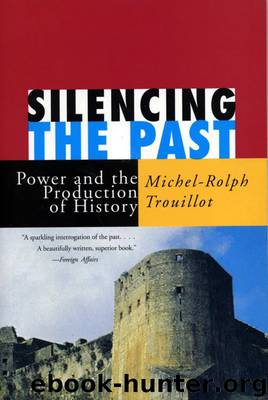Silencing the Past: Power and the Production of History by Trouillot Michel-Rolph

Author:Trouillot, Michel-Rolph [Trouillot, Michel-Rolph]
Language: eng
Format: epub
Publisher: Beacon Press
Published: 2012-01-31T00:00:00+00:00
Good Day, Columbus
4
I walked past Vasco da Gama’s body with premonitions of typhoons. I was in Portugal, at the Mosteiro dos Jéronimos, right where Europe started to redefine the world. Here Lisbon becomes Belém, in honor of Bethlehem, to absorb in the memory of the West the Orient where Christ was born. Here Da Gama knelt for his last blessing before facing the seven seas. Here he was brought back to be buried as if to engrave on this soil the history of uncharted oceans.
There were too many facts for that story to be simple—too many names crowding my thoughts, too many relics for a single image. This monastery was named after one Saint Jerome whose Hieronymite followers ran plantations in Santo Domingo. Its monstrance was made with gold that Da Gama, en route to Calicut, extorted from the Muslim sultan of Kilwa. Its main entrance faced an avenue called India. Everything here evoked an elsewhere and the hidden face of Europe: Christendom had not left a single continent untouched. The world started and ended here with a confusion of tongues and cultures.
The babel of Belém intruded on my memories: Jerome, Jéronimos, Hieronymites. Had not that name become a symbol of native resistance in the United States after an Indian born Goyahkla, in what used to be Mexico, was renamed Geronimo? My feelings as jumbled as the lands of Arizona, I kept wondering why so many Europeans deny that they created the United States. Didn’t the line go straight from Afonso de Albuquerque to Albuquerque, New Mexico? Had not Da Gama died in Cochin less than five hundred years before Vietnam?
Outside the monastery, the sun over Belém spoke of pasts unknown and uncertain waters. I turned away from the Jéronimos. On the Avenue of Brazil, Lisbon flaunted further its long encounter with the seas. Yet the surfeit of names continued to defy the established story. There were too many signs here for history to remain official. Images of India, of Indians north, south, and west—from Calicut to Brazil, from Brazil to Arizona, persistent flavors of continents conquered in the name of spices and gold filled up the empty space between the monuments.
Moving among these ghosts, I savored the irony of this human landscape caught in the wheels of time. A clutter of colonial paraphernalia displayed itself on and off an avenue called Brazil—after the colony that for a brief moment was Portugal’s metropolis. On my right, overlooking the Tagus, the Tower of Belém reminded me of piracy, of the time when Europe had to defend itself against its own. On my left, a few hundred yards from the Tower, the Monument to the Discoveries repackaged Portugal’s past in a grandiose display of adventurous innocence.
A tribute to Prince Henry the Navigator, whose quincentennial it honored in 1960, the huge structure shows the Prince leading the Portuguese to the Discoveries. But the memorial was just too big to convince me of its chastity: its arched mass spoke of conquest, of Henry’s desire to bend the onlooker under his will.
Download
This site does not store any files on its server. We only index and link to content provided by other sites. Please contact the content providers to delete copyright contents if any and email us, we'll remove relevant links or contents immediately.
| Africa | Americas |
| Arctic & Antarctica | Asia |
| Australia & Oceania | Europe |
| Middle East | Russia |
| United States | World |
| Ancient Civilizations | Military |
| Historical Study & Educational Resources |
Underground: A Human History of the Worlds Beneath Our Feet by Will Hunt(11274)
Navigation and Map Reading by K Andrew(4562)
Sapiens by Yuval Noah Harari(4560)
Barron's AP Biology by Goldberg M.S. Deborah T(3640)
The Sympathizer by Viet Thanh Nguyen(3528)
5 Steps to a 5 AP U.S. History, 2010-2011 Edition (5 Steps to a 5 on the Advanced Placement Examinations Series) by Armstrong Stephen(3410)
Three Women by Lisa Taddeo(2927)
The Comedians: Drunks, Thieves, Scoundrels, and the History of American Comedy by Nesteroff Kliph(2794)
Water by Ian Miller(2599)
Drugs Unlimited by Mike Power(2197)
The House of Government by Slezkine Yuri(1852)
DarkMarket by Misha Glenny(1851)
The Library Book by Susan Orlean(1740)
A Short History of Drunkenness by Forsyth Mark(1734)
Revived (Cat Patrick) by Cat Patrick(1684)
The Woman Who Smashed Codes by Jason Fagone(1654)
And the Band Played On by Randy Shilts(1625)
The House of Rothschild: Money's Prophets, 1798-1848 by Niall Ferguson(1622)
Birth by Tina Cassidy(1575)
